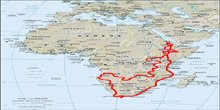We left Scarlet at the small but busy harbour of Mokowe. After spending the night we boarded the first small ferryboat departing in the morning, which took us across the Lamu Town in 30 minutes for Ksh50 each.
 The small but busy harbour at Mokowe
The small but busy harbour at MokoweWe walked the streets slowly for hours, watching people going about their businesses, visiting beautifully refurbished old Swahili houses (now mostly hotels) and the interesting ethnological museum. We ate coconut rice, chipatis, pilau and fish curry in local canteens (where Caro was the only woman) and wondered about the quality of the tap water while relishing the conversations and atmosphere. What we enjoyed the most was siting for hours on the fort’s steps and watching town life on the main square.
VIDEO of people passing by on the main square.
 Lamu's main square
Lamu's main square  View of the main square from the fort
View of the main square from the fort  The fort's entrance
The fort's entrance
 Lamu's streets
Lamu's streets Shella beach
Shella beachOne evening we went to the local cinema to watch a Bollywood movie. The pirate DVD was scratched and kept skipping during the first song. People started complaining loudly and eventually the disc was changed and the movie carried on. The seats weren’t very comfortable and people laughed out loud or commented on scenes while smoking their cigarettes. There were a few other women in the audience, although it is the afternoon screenings which are reserved for women.
We also met a local, really an expat from Yemen, who invited us for a drink followed by a visit to his shop. He was selling perfumes and bui-bui, the black robes and veils most Lamu women wear in public. He got Caro to try one on. The shop assistant was very helpful helping me put it on, but I wondered what she thought of the whole scene.

Our new friend then invited us to his house for a modest dinner of bread, honey and sweet tea. His home he shared with his aging mother and the two shop assistants. He spoke a lot, and although his English was far better than our Swahili or Arabic, we struggled to really understand each other. We gathered that he was busy refurbishing his house and transforming it into a hotel, which we believe will be very nice when finished. We suspect he may have been practicing his English with us, as well as advertising his future guest house. He had also quite obviously been chewing miraa, a legal narcotic, and was becoming very animated and obviously in for a long sleepless night. So when he invited Steve to share a miraa mastication session we had to use treasures of imagination and diplomacy to refuse politely. We felt bad refusing, as he had been so generous with us, but this miraa seems a bit hectic . It is a root chewed by many people in East Africa (mostly men it seems) and it seems to be quite a potent drug judging by our new friend’s glazed eyes and his strange stories of being transported to the White House and chatting with Barak Obama and a golden eagle…
We are amazed at how popular Barak Obama is in Tanzania and Kenya. There are stickers of him on every matatu (bus), prints of his portraits on women’s kangas (sarongs), etc. It seems that people’s expectations are huge, although we haven’t found out yet what these expectations are…






No comments:
Post a Comment